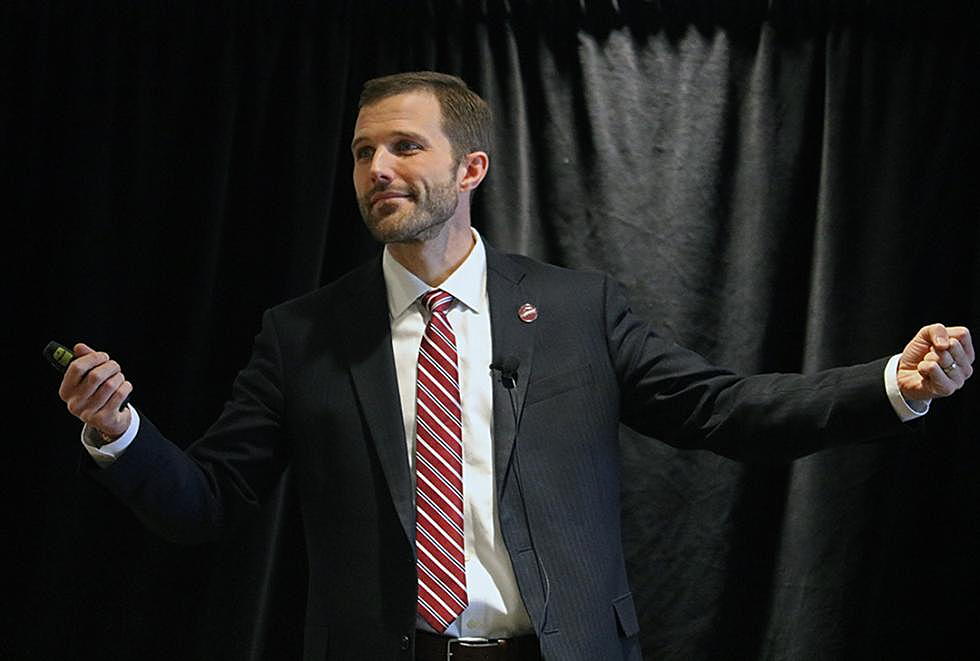
UM ready to evolve in “a world full of disruptions,” school president says
When General Electric first appeared on the Dow Jones Industrial Average in 1896, the company was lauded as a cornerstone of industrial might, a reputation it would hold for more than a century.
But now, with the digital revolution in full swing, the powerhouse of American ingenuity is searching for its place in a changing world, one where transformation will be key to survival.
“The largest taxi company in the world today (Uber) owns no vehicles, and the largest accommodations provider (Airbnb) owns no real estate,” said Seth Bodnar, president of the University of Montana. “The largest media company, or one of the most impactful (Facebook), creates no content. This is a world full of disruptions.”
Bodnar, a veteran of the U.S. Army's 101st Airborne Division and a former GE employee who focused on business transformation, drew from his own experience Monday at City Club Missoula to highlight the world in which the University of Montana faces as it stares down its 125th anniversary.
The flagship campus has confronted a number of challenges in recent years and has struggled at times for a sense of new identity. But unlike some dying institutions, Bodnar said, UM is full of promise, and it has the tools it needs to succeed.
“UM is facing a defining moment,” he said. “We've seen enrollment declines, we've seen struggles and we've seen the budget challenges. But this is a time when we as a community are pulling together to chart a new course for this great institution. We have all the right ingredients for what students need to be successful in the context of this changing world.”
Bodnar's presentation and its blend of history with necessity offered many of the several hundred guests in attendance on Monday their first look at UM's new president, and his goals for the school.
The West Point graduate who earned two master's degrees from Oxford University drew from his lessons in the service, where he learned to recognize the need to write a new strategy when the old tactics no longer work.
In some ways, he said, the same holds true for UM.
“Excellence isn't an accident,” he said. “You don't happen upon excellence by chance, and you don't sustain it without hard work. It also requires that you seek a better way.”
Bodnar outlined four areas of focus, including excellence and innovation, and addressing what he described as the school's structural deficit. To resolve it, the university will place renewed focus on recruitment and retention, among other developing strategies.
“This is not about glossy brochures – it's not about stuffing people's mailboxes with postcards,” he said. “It's about making sure the perceptions of the University of Montana align with the reality of University of Montana. We're going to have to spend some time and some resources to structure ourselves to better communicate the value of a UM education to the right people through the right channels, and with the right frequency to bring more students here.”
Preparing today's students for tomorrows jobs shouldn't be hard to do, Bodnar said, given the school's list of accolades and achievements. It's professional schools are highly rated, and three of its researchers were recently named among the top 1 percent of the world's most influential scientists.
The university has one of the best placements for students into medical school, and the role of social sciences and the humanities will grow more crucial as technology advances. While nearly half of tomorrow's jobs don't yet exist, Bodnar added, the need for a balanced education stands among the stories UM must grow more apt at telling.
“If you're going to succeed in this world, you have to be able to work across disciplines,” Bodnar said. “You have to be an agile, lifelong learner who can solve complex challenges at the intersection of disciplines.”
Bodnar said UM also must strive to “embody the principles of Missoula” and place “people first.” That includes a renewed focus on diversity and the development of those who teach on campus.
Last week, Bodner also met with members of the City Council and Missoula County as the university looks to blur the lines between the Mountain Campus and the wider community. The momentum, he said, is pointed in the right direction.
“It's critically important that the people who work at our university – the people who have dedicated their lives to the vocation of higher education – that they have a place where they can work and fulfill their full potential to do the best work of their lives,” he said.
“The university and this city are inextricably linked. As Missoula goes, so goes the University of Montana, and vice a versa.”
